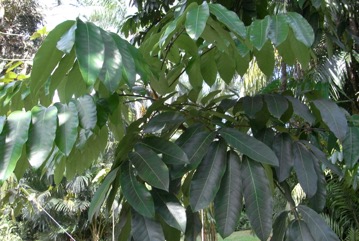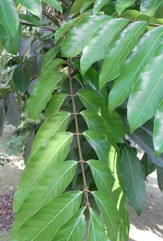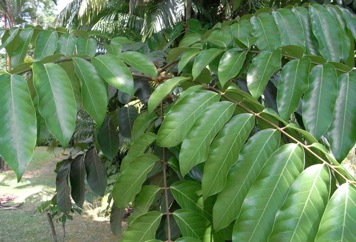Bitter kola, Crab nut

A tropical plant. It grows in the rainforest. It suits humid locations. It can also be in savannah woodland, palm groves and along river banks.
Also known as:
Bepale, Boco, Boculamape, Boncom-hadje, Boncom-o, Boru, Buaque, Bugwere, Bunhogone, Buweci, Carahane, Cola-amargoso, Cola-malegossa, Coque, Dona, Ebegogo, Engang, Gobi, Godjo, Irere, Karaba, Karapa, Kola-malgos, Malo, Mambodadje, Mbolu, Nanga, Ngan, Ngoze, Pada-di-kola, Punhe, Siti-malgos, Weti-krapa
Synonyms
- Carapa grandiflora
- Carapa guineensis Sweet ex A. Juss.
- Carapa gummiflua C. DC.
- Carapa microcarpa A. Chev.
- Carapa surinamensis
- Carapa velutina C. DC.
- Carapa touloucouna Guillem. ex Perr.
- Granatum surinamensis (Miq.) Kuntze
- Trichilia procera Forsyth
Edible Portion
- Seeds, Fruit
Where does Bitter kola grow?
Found in: Africa, Angola, Brazil, Burkina Faso, Cameroon, Central Africa, Central African Republic, CAR, Colombia, Congo DR, Costa Rica, Côte d'Ivoire, East Africa, Gabon, Guiana, Guianas, Guinea, Guinée, Guinea-Bissau, Ivory Coast, Nigeria, Peru, Sao Tome and Principe, SE Asia, Senegal, Sierra Leone, Singapore, Suriname, Tanzania, Uganda, West Africa
Notes: There are 25 Carapa species. There are 3 Carapa species in tropical America.
Status: It is commonly used in West Africa.
Growing Bitter kola, Crab nut
Cultivation: Plants can be grown from seed. The seed germinate easily. Seeds should be planted within 2 months. The young plants should have light shade.
Edible Uses: The seeds are used to make a type of butter. The ripe fruit are eaten raw.
Production: The plant is slow growing. In Congo fruit are available November to December.
Nutrition Info
per 100g edible portion| Edible Part | Energy (kcal) | Protein (g) | Iron (mg) | Vitamin A (ug) | Vitamin c (mg) | Zinc (mg) | % Water |
|---|---|---|---|---|---|---|---|
| Seeds | - | - | - | - | - | - |
Bitter kola, Crab nut Photos



References
Ambe, G., 2001, Les fruits sauvages comestibles des savanes guinéennes de Côte-d’Ivoire : état de la connaissance par une population locale, les Malinké. Biotechnol. Agron. Soc. Environ. 5(1), 43-48
Bremness, L., 1994, Herbs. Collins Eyewitness Handbooks. Harper Collins. p 41
Danforth, R.M., & Boren, P.D., 1997, Congo Native fruits. Twenty-five of the best. Privately published. p 68
Grandtner, M. M. & Chevrette, J., 2013, Dictionary of Trees, Volume 2: South America: Nomenclature, Taxonomy and Ecology. Academic Press p 101
Jardin, C., 1970, List of Foods Used In Africa, FAO Nutrition Information Document Series No 2.p 40
Katende, A.B., Birnie, A & Tengnas B., 1995, Useful Trees and Shrubs for Uganda. Identification, Propagation and Management for Agricultural and Pastoral Communities. Technical handbook No 10. Regional Soil Conservation Unit, Nairobi, Kenya. p 156
Keay, R.W.J., 1989, Trees of Nigeria. Clarendon Press, Oxford. p 348
Mangambu Mokoso Jean De Dieu, et al, 2015, Etudes ethnobotanique et ethnolinguistique des ressources forestieres ligneuses utilisees par la population du coulour Ecologique du Parc National de Kahuzi-biega (R. D. Congo). European Journal of Scientific Research May 2015.
Prodr. 1:626. 1824
Terashima, H., & Ichikawa, M., 2003, A comparative ethnobotany of the Mbuti and Efe hunter-gatherers in the Ituri Forest, Democratic Republic of Congo. African Study Monographs, 24 (1, 2): 1-168, March 2003
Vivien, J. & Faure, J.J., 1985, Abres des forets dense d'Afrique Centrale. Agence de Cooperation Culturelle et Technique. Paris. p 248
Vivien, J., & Faure, J.J., 1996, Fruitiers Sauvages d'Afrique. Especes du Cameroun. CTA p 197
World Checklist of Useful Plant Species 2020. Royal Botanic Gardens, Kew